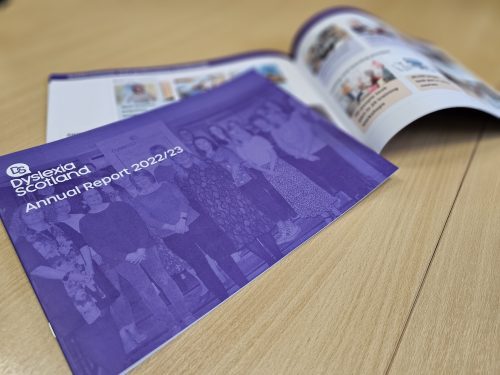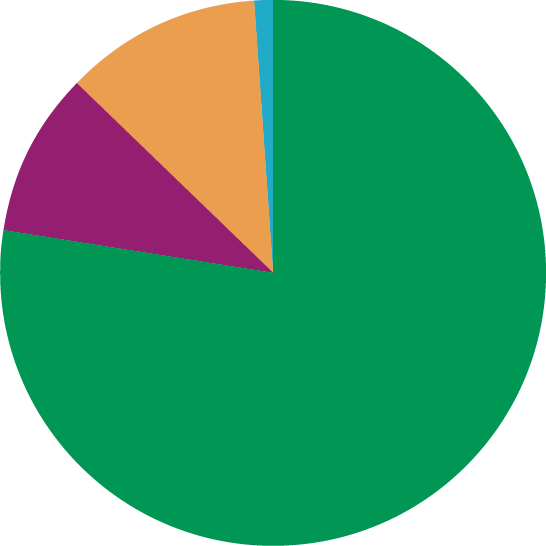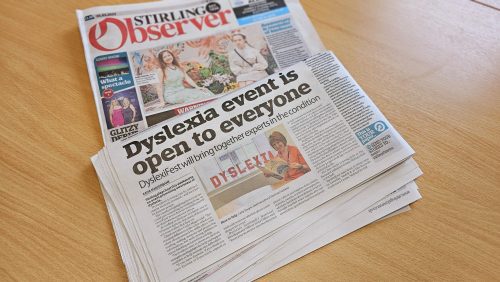Annual Report 2022/23
Access the report content online here or download the printable.


Contents
Chair’s report


The period from 1 April 2022 until the end of March 2023 marked the first year of our aspirational new Strategic Plan for 2022-25, which set out the journey we are embarking on towards a dyslexia-friendly Scotland. We are leading this movement, but we cannot do it alone. Through our changemakers’ programme, people are taking positive action to be dyslexia-inclusive in their home, learning, work or social environment.
Dyslexia Scotland has adapted well to a post-Covid world, including embracing a hybrid model of working which combines digital delivery of our services with vital face to face support for the dyslexic community. We have extended our reach through social media, our newly designed websites and online provision, and maximised the benefits of in-person interaction, with the return of popular events such as our Youth Day, DyslexiFest and residential networking for our branch and Adult Network volunteers.
We continue to work hard to secure sufficient funding to deliver our objectives. We were successful in securing renewed core funding from the Scottish Government and the Corra Foundation to improve outcomes for children, families and adults with dyslexia. This core Scottish Government support is vital for us to deliver the impressive range of activities outlined in this report. At the time of writing however, we have had no firm commitment beyond September 2023 for our main core grant. A key priority for the Board of Directors remains to diversify our funding sources from the public and private sectors as well as by generating income from our services where appropriate and possible.
I’d like to highlight a couple of impressive achievements:
- Dyslexia and inclusive practice Professional Recognition programme (accredited by General Teaching Council for Scotland (GTCS), delivered in collaboration with Education Scotland)
This important year-long programme, now entering its third year, improves the confidence, skills and expertise of teachers across Scotland to support dyslexia in schools. In response to increasing demand, the number of available spaces has increased incrementally each year – 30 in year 1, 35 in year 2 and 72 in year 3. A national community of practice is evolving as the graduates or ‘alumni’ from each year contribute to the next year’s learning and development. - Sean Connery Dyslexia Initiative (Supported by the Sean Connery Foundation)
This unique partnership with the City of Edinburgh Council has already delivered significant improvements for the dyslexic learners and their families who have taken part in its first year.
My heartfelt sincere thanks go to the generous funders, supporters, and numerous dedicated volunteers who work with Dyslexia Scotland to support dyslexic people in so many different settings. These include our inspirational President, Sir Jackie Stewart, our Vice Presidents, Ambassadors, Young Ambassadors, my fellow Directors, Council members, national volunteers including the Adult Networks and all those volunteers involved in our network of branches across Scotland. Their commitment throughout the year is exemplary. as well as to our members, tutors, assessors and trainers.
Finally, I am indebted to the staff team, whose dedication and hard work this year have empowered and made a difference to thousands of dyslexic people.
David Shaw
Chief Executive’s Voice


In this annual report, we must acknowledge our special anniversary.
December 2023 marks Dyslexia Scotland’s 55th birthday. Over time, we have become maturer and wiser, and have achieved a great deal along the way.
In the last 20 years alone, we’ve responded to 37, 754 Helpline enquiries. Throughout this report, you’ll find many more impressive statistics from our work, but they mean nothing without the human stories behind them. For each of these numbers represent lives changed.
The annual report is always time for us to look back with pride, and to look forward with anticipation. We know there is much still to change – and we are primed for the adventure.
Take a moment to reflect with us at this stop, and consider how far we have come, not only in the last 55 years, but in this last year alone.
Cathy Magee
Objectives and activities
Dyslexia Scotland is the national voluntary organisation representing the needs and views of dyslexic people in Scotland. Dyslexia Scotland aims “to inspire and enable people with dyslexia, regardless of their age and abilities, to reach their full potential in education, employment and in life”, through:
- Promotion of national policies, standards and best practice for early recognition, assessment and training for dyslexia in Scotland.
- Promotion of equality for all dyslexic people in all areas of life.
In order to achieve our vision, we have set out four strategic aims for 2022– 2025:
- To provide and promote high quality services
- To influence and achieve positive change at a national and local level
- To give people with dyslexia an effective individual and collective voice
- To ensure that Dyslexia Scotland is a sustainable, efficient and effective organisation
This report covers the 2022-2025 Strategic Plan.
Dyslexia Scotland’s core services include
- A confidential National Helpline
- A national Tutor List and professional development for tutors
- A national list of approved Assessors (Psychologists and Dyslexia Specialists) who carry out assessments to identify dyslexia and other associated difficulties
- Advice on assessments for children, young people and adults
- An in-house Library, information leaflets and guides
- Conferences, masterclasses, special events, workshops and dyslexia awareness training
- Support of initiatives and projects for the Scottish Government and other partners, including professional learning opportunities for teachers
- Local events, activities and support provided through our network of volunteer-led Branches and Adult Networks
- A quarterly magazine and a range of services for members
- Two websites and active social networks.
Strategic Plan
Our 3-year Strategic Plan 2022 – 2025 was developed following consultation with members and key stakeholders about the priorities for the next three-years. That Plan was launched in March 2022.


FInancial Review
A deficit of £42,939 arose during the year (2022: surplus of £36,937). During the year, eighteen (2022: eighteen) branches operated under the charity number of Dyslexia Scotland and are incorporated in the accounts. At the year end, £476,843 (2022: £519,782) of reserves were carried forward.
During the year, funding was received from the Scottish Government to engage consultants in the following areas: online animation workshops for children; parent masterclasses; conference organisation; magazine printing costs; design of materials/resources; training for tutors and branches; tutor recruitment interviews; Panel training for GTCS programme; DyslexiFest speakers. Funding received from the Sean Connery Foundation was used to pay consultants involved in delivering the Sean Connery Dyslexia Initiative in partnership with the City of Edinburgh Council.
Sources of income
Total: £510,800


Expenditure
£553,730


Reserves policy and ongoing concern
The Board’s Reserves policy is to seek to maintain its unrestricted reserves at a level at least equivalent to six months overhead costs. The Board reviews this policy regularly based on projections for income and expenditure, our current liabilities and an estimate of likely needs and risks over the next few years.
Currently our free reserves would cover less than 12 months running costs. The reserves are at this level because the Scottish Government grant has not been adjusted for inflation for many years and is not secure from year to year. None of our other current funding lines are confirmed to extend beyond 2025. The Board would therefore need to use unrestricted reserves for core costs to continue to run the charity whilst sourcing alternate funding if some or all of the funding lines were not continued.
During the year, we used a combination of unrestricted reserves together with part of our core Scottish Government grant to fund the three Development Officer posts.
Given the current financial crisis, the Board considers it prudent to seek to maintain healthy unrestricted reserves in order to meet the anticipated increasing demand for support and services for children, young people and adults with dyslexia.
Principal funding sources
Dyslexia Scotland was the recipient of a number of substantial donations in the financial year. These include: the continued funding for the Chief Executive post from Dr. Walter Scott; funding from the Sean Connery Foundation towards our delivery costs for the Sean Connery Dyslexia Initiative in collaboration with the City of Edinburgh Council; a grant towards our running costs from The Robertson Trust; a number of charitable donations from individual supporters and fundraisers. We are extremely grateful to all these donors.
Other principal funding sources for the year under review are: the Scottish Government (core grant as well as funding for the Addressing Dyslexia Toolkit, online modules, Dyslexia and inclusive practice Professional Recognition programme and implementation of the Making Sense review); Corra Foundation for core funding; donations and income generated by the activities of the charity, such as the Education Conference and training. Other than funding from the sources mentioned above, the principal funding sources have been unrestricted contributions to the core costs of the charity and as such have been applied in support of all its key objectives.
Investment policies
Under the Memorandum and Articles of Association, the charity has the power to invest any money that the company does not immediately require in any investments, securities or properties. As there are few funds for long-term investment the Directors, having regard to the liquidity requirements of operating the charity and to the reserves policy, have operated a policy of keeping available funds in interest bearing bank accounts.
Risk management
The annual strategic review and forward planning day considers the risks to which the charity is exposed and identifies what needs to be in place to manage these risks through the year. The risks faced by the company fall into two categories, internal and external.
The Board of Directors completes a Risk Management Analysis each year and reviews it at regular intervals. Internal risks are minimised by the implementation of procedures for authorisation of transactions and projects and to ensure consistent quality of delivery for all operational aspects of the company.
External risks relate largely to the continued funding of the company. The current economic climate, exacerbated by the impact of the Covid-19 global pandemic, will inevitably present challenges for Dyslexia Scotland, which the Board will manage and monitor. It is hoped that support from both private and public sectors will continue to be secured, to help mitigate the long-term financial impact of the financial crisis on the charity.
Any variation from the business plan has an associated risk assessment that is presented to the Board of Directors.
Governing structure and appointment of Directors
Dyslexia Scotland consists of the Board of Directors, the Members’ Representative Council, local Branches, the Adult Networks and individual Members. In the reporting period, there were seven members of staff, all of whom were full time. Furthermore, a part-time educational consultant leads on the Dyslexia Initiative being delivered by the City of Edinburgh Council with the support of the Sean Connery Foundation.
The Board is made up of a minimum of five and a maximum of twelve Directors, no fewer than two of whom are Council members nominated by the Council. The Members’ Representative Council, which advises the Board, is comprised of all current Directors of the company, the Company Chair, one representative of each of the Branches, one member of the Adult Network and any other persons as appointed by the Council. The minimum number of members of the Council is two Directors and two Branch representatives. The Chair of Council was appointed to the Board in November 2020.
The Company Chair and Directors are elected at the Annual General Meeting. The Company Chair, who must be a member, acts as the Chair of the Board of Directors. Re-appointment of Directors by members at the Annual General Meeting may occur on a rolling basis following every three-year term served by each Director. The Directors may also co-opt other persons to the Board of Directors, with a limit of two persons at any one time.


Director induction and training
After election, an induction programme is offered to all new Directors. In addition, all Directors receive ongoing access to training as appropriate and an information pack that contains the Memorandum and Articles of Association, roles and responsibilities of being a Director, and background information on the charity.
The full Board of Directors meets at least quarterly (in the reporting period it met five times). There are five Strategic Plan Sub Groups responsible for implementing key aspects of the three-year strategic plan. These Sub Groups report to the Board of Directors and Council. The Board receives accounts at each meeting. The Board spends a day each year undertaking a strategic review and forward planning for the charity. Progress against strategic objectives is discussed at each meeting. The Board has delegated powers to make certain day-to-day decisions regarding the charity’s operations to the Chief Executive. A work plan and budget is agreed by the Board. The strategic plan in operation during the reporting period started at the beginning of April 2022. This three-year plan was produced following consultation with Dyslexia Scotland’s members in 2021.
New achievements
We’ve achieved a huge amount in the last year, well above and beyond the day-to-day service delivery.
These are our top-picks of the year’s highlights.
Teacher training
Delivered the GTCS Professional Recognition in Dyslexia and Inclusive Practice programme to 2 year groups of teachers and lecturers (54 in total).
Other achievements
Brief interventions
1824 Helpline enquiries answered
112 social media messages answered
398 tutor enquiries answered
Awareness materials distributed
45,575 blue ribbons
2764 magazines
139 awareness cards
8228 leaflets
Face to face
2330 people took part in 71 events
1348 hours of free tutoring
12 free assessments to identify dyslexia
1.8 million social media impressions, 538,000 engagements
Training and learning provided
751 people took part in 25 training workshops
20,330 people took part in online courses
16 teachers gained Professional Recognition in Dyslexia and inclusive Practice
70,466 people used our website 103, 607 times
People
People make Dyslexia Scotland what it is. Some have moved on, leaving lasting legacies, some have joined, bringing fresh perspectives and new skills to our work.
We said farewell to Volunteers Manager Helen and welcomed Sue in her place. Katie, formerly a career coach in the organisation, took up a brand new role leading our creative and digital streams of work.
Volunteers continue to be essential to our work. They deliver services like our Helpline and Dyslexic Adult Network. Our Ambassadors and Board of Directors are also all volunteers.
At the time of reporting, Dyslexia Scotland had 32 national volunteers, 9 Young Ambasadors and 80 local Branch volunteers.
Profile
We want to make sure that people with dyslexia are included and respected in all aspects of society.
By keeping dyslexia highlighted in the media, we’re making sure that more people learn about what dyslexia is – and how it affects people in Scotland.
We’ve featured in the news with stories about:
- Our dyslexia and mental health documentary
- DyslexiFest
- Our work in City of Edinburgh Council schools
- Our campaign, ‘There’s Nothing Comic About Dyslexia’
- Dyslexia and genetics
- Dyslexia and Gaelic


Impact: lives changed
Adults
Support worker Reynel would have been unfairly deported if it wasn’t for the intervention from Dyslexia Scotland.
He had failed the Life in the UK test many times but The Home Office didn’t accept his overseas evidence of dyslexia. He couldn’t afford the cost of assessment here in Scotland. A free assessment turned the decision around.
Ross regularly contributes to Dyslexia Voice magazine. He said, “Being part of a community of likeminded people is so important to me. I get a real kick out of writing the articles. I can’t tell you how much it personally helps me to develop something of a passing interest into something much wider and deeper than I could ever imagine. I will always be thankful for Dyslexia Scotland.”
Children and young people
Our partnership with City of Edinburgh Council schools is helping young people and their parents and carers. One parent said, “I have noticed a huge change in my daughter when it comes to doing literacy work now. She is writing short stories on the home computer, and she has so many ideas. She is more confident in trying to spell words and her reading has improved a lot too.”
We create opportunties for young people to play to their strengths and meet others with dyslexia. This parent’s feedback shows how important these activities are. “Our daughter was behind in her school work, asking us why is she is so thick, which is heartbreaking for a parent. She had lost so much confidence before finding out she was dyslexic. When she came to your young people’s day, it gave her a massive confidence boost.”
Access to free tutoring is helping to close Scotland’s poverty-related attainment gap. One mum told us, “Your tutor has been absolutely amazing for my son. Through Peter’s support and encouragement, my son has gone from being a school refuser to someone who is sitting 8 National 5s and getting great results. He would not be here without the tutor’s help and as a single working mother I couldn’t have afforded this on my own.”
Changemakers
Teachers who have undertaken our Professional Recognition programme are making an impact in their school communities.
”Sarah is making our school dyslexia friendly. We have seen children who have lacked confidence in their literacy skills flourish to the point they can confidently talk about the advantages and disadvantages of this with others.”